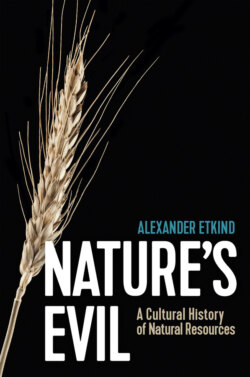Читать книгу Nature's Evil - Alexander Etkind - Страница 32
Fish
ОглавлениеIn 1784 the Massachusetts State House passed a resolution to install a wooden carving of a cod above the chamber, ‘as a memorial of the importance of the Cod-Fishery to the welfare of this Commonwealth’. The most important source of protein in colonial America, cod was irreplaceable as a food source for slaves on the sugar islands and Catholics during their fasts. The cod’s biology meant it could be caught in vast numbers, preserved and consumed. Each fish weighed 10 to 12 kilos or even more. Its muscular, non-oily flesh made it easy to dry, and it contained 80 per cent protein – much more than dried beef. Dried cod could be kept in a ship’s hold for years and transported anywhere in the world. Oily fish, such as herring, was not suitable for drying. It had to be smoked or pickled in brine, which meant it was heavier to transport or didn’t keep well.
The fishing technique was simple. Cod was caught using homemade tackle and bait consisting of fish guts from a previous catch. The stunned fish were split, generously salted and pegged out to dry in the sun and wind. This could be done right on deck, but large catches had to be landed and dried on the shore. Cod’s liver was dealt with separately. It produced oil that was used for greasing anchors and later for lubricating steam engines. In Italy and Spain, cod – baccala – is still considered a traditional dish. The industry flourished on account of the cod’s unusually prolific breeding cycle: the average female cod produces 3 million grains of roe. The sea belonged to everyone, but a catch of fish belonged to the fisherman concerned. In order to get paid, a fisherman would cut out the tongues of all the fish he had caught and collect them in a box on the deck.
Europeans started to enjoy dried cod from the northern shores of Scandinavia as early as the thirteenth century; soon it became one of the staple products of the Hanseatic League. In Northern Europe, people preferred herrings soused in brine pickle, but in Southern Europe, and then in America too, dried cod was more popular. From the sixteenth century onwards, the Basques fished regularly near Newfoundland. They organised triangular trade by carrying Spanish wool to England, taking English woollen and manufactured goods to the American colonies and then, on the return trip, transporting salted cod to northern Spain: one such trip took a year.9 The shipowners took the lion’s share of the profits – the biggest houses in Boston, Salem and other ports belonged to them. In the 1640s, British capital was added to the mix and a new triangle developed: English ships unloaded finished goods and salt at Boston, from there shipped cargoes of cod to Jamaica and other Atlantic islands, where they loaded up with sugar to take back to England. Cod disappeared from coastal waters – this always happens with communal resources. The Boston fishing schooners went further and further out to sea, all the way to Newfoundland. The risks grew fast, and insurance premiums increased too. This meant the fishermen became even more dependent on the merchants who gave them credit or provisions. In mid-ocean they dried the cod on board their ships. This resulted in a large quantity of inferior-quality dried cod, suitable only for the slaves on the sugar islands. As the American ships forced out the British vessels supplying the West Indies, they took industrial quantities of molasses back to Boston, where they distilled rum, in contravention of the mercantilist Navigation Acts. Worse still, the American fishermen sold their cod at Saint-Domingue (Haiti) and other French colonies and bought molasses there cheaply. In retaliation, the English fleet began seizing American vessels.
Mercantilist law primarily defended the interests of the plantation owners and sugar traders, which conflicted with the interests of the fishing industry. After the end of the Seven Years’ War, Parliament introduced stamp duty – essentially, a tax on labour. Within the American colonies, this tax had to be paid on all deals, contracts and legacies. As a measure against smuggling, London sent additional ships to the Atlantic. This triggered the protests with their famous slogan ‘no taxation without representation’. Protesters occupied commercial ships in Boston Harbour and threw chests of tea overboard. The choice was highly symbolic – tea was the only British commodity that the American colonies did not have. During the War of Independence, the New England fishing fleet supplied the revolutionary troops with gunpowder, rum and provisions from the West Indies, as well as the usual dried cod. During the peace talks, the fishing rights off Newfoundland were one of the most hotly debated subjects of negotiation. In the end, the Americans asserted their rights at the Treaty of Paris in 1783. It was only 200 years later that the Canadian government introduced a moratorium on cod fishing off Newfoundland.
Fish and meat share one paradoxical quality. In any market, fresh meat is more expensive than frozen. But it takes more capital and labour to produce frozen meat. This is also the case with fish and some other perishable goods: fresh costs more than conserved, the locally produced costs more than the product delivered from a distance. The economist will say that, when we pay for a piece of fresh meat or fish, we are, in fact, paying not only for it but also for all the bits that are thrown away. This paradox is one of the features of modern life. Only when we pay for a perishable local product do we add to the cost of catching and processing a unit, the cost of similar units that the buyer does not see or wish to hear about.
